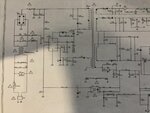bmandl
Full Member level 4
Hello guys,
I am looking at schematic of a SMPS for some audio system and I can't figure out, how the heck does that high frequency transformer work... I don't understand the winding for supplying IC3 (PWM controller). Is this primary or secondary winding and how can voltage be induced on it? I understand, that D20 is rectifire diode, so this is half-bridge rectifire for IC3 supply, but where does that voltage come from? I can measure variating DC voltage on cathode of that diode.
Thank you for answers.

[found at: share.icloud. com /photos /0qscQj-OiHmP9LjktyoVIb1aw]
I am looking at schematic of a SMPS for some audio system and I can't figure out, how the heck does that high frequency transformer work... I don't understand the winding for supplying IC3 (PWM controller). Is this primary or secondary winding and how can voltage be induced on it? I understand, that D20 is rectifire diode, so this is half-bridge rectifire for IC3 supply, but where does that voltage come from? I can measure variating DC voltage on cathode of that diode.
Thank you for answers.

[found at: share.icloud. com /photos /0qscQj-OiHmP9LjktyoVIb1aw]
Last edited by a moderator: